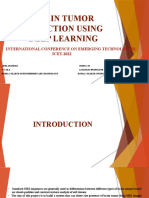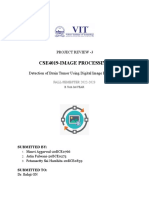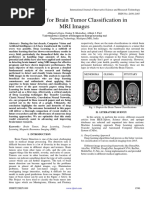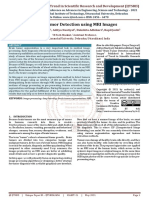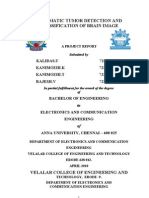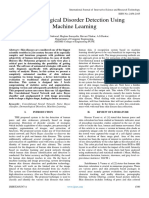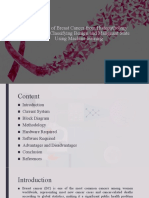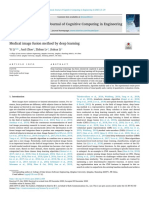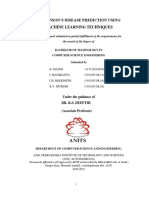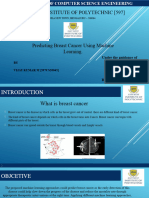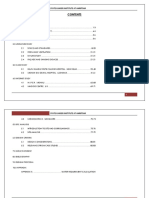Brain Tumor Segmentation and Detection Using Deep Learning
Uploaded by
mohammad arshad siddiqueBrain Tumor Segmentation and Detection Using Deep Learning
Uploaded by
mohammad arshad siddiquee-ISSN (O): 2348-4470
Scientific Journal of Impact Factor (SJIF): 5.71
p-ISSN (P): 2348-6406
International Journal of Advance Engineering and Research
Development
Volume 7, Issue 04, April -2020
Brain Tumor Segmentation And Detection Using Deep Learning
Mohd Arshad Siddique 1, Arham Ansari 2, Mohd Asif Siddique 3, Dr. Mohd Riyazoddin Siddiqui 4
1,2,3
Final year Student, Department of I.T, M.H. Saboo Siddik college of Engineering
4
Associate Professor, Department of I.T, M.H. Saboo Siddik College of Engineering
Abstract — A brain tumor is a collection, mass, or growth of abnormal cells in the brain. It occurs due to abnormal
formation within the brain. Recently it is becoming a major cause of death of many people, so to save a life, immediate
detection and proper treatment need to be done. Determination of tumor extent is a major challenge in treatment
planning of brain tumor. Diagnosis and treatment of brain tumors require a delicate segmentation of brain tumors, as a
prerequisite. Non-invasive technique like MRI has emerged as a frontline diagnostic tool for brain tumor diagnosis.
Manual segmentation of brain tumor extent from MRI volumes is complicated and time-consuming task due to complexity
and variance of tumors. This conventional method relies on physician’s experience and knowledge which conventionally
cost a lot of precious time. In this context, a fully automatic segmentation method is needed for an effective brain tumor
detection assisting the doctor in diagnosis and treatment planning. Recently various techniques have been developed for
automatic detection of brain tumor. Deep learning method have been proved to be popular compared to other state of the
art method as it achieves promising result. In this paper, we have presented several works performed by the different
authors for detecting the brain tumor using deep learning techniques such as DNN and CNN, and also highlight the
proposed method of various authors by summarizing the papers.
Keywords — Brain Tumor, Glioma, MRI, Deep Learning, CNN, Segmentation.
I. INTRODUCTION
Brain tumor is a growth of abnormal cells and uncontrolled cells divisions within the brain. There are many different
types of brain tumor exist. Malignant and benign are the two main types of brain tumor that have been identified.
Malignant are cancerous tumor that contain cancer cells, while Benign tumor are non-cancerous tumor. Generally, brain
tumour can be categorized as primary brain tumor or secondary brain tumor. Primary brain tumors originate in the brain
while secondary brain tumor or metastatic tumor occur due to spreading of cancer cells in the brain from another organ of
the body, such as your lung or breast.
Gliomas are one of the most common types of primary brain tumors that originate from glial cells [1]. It
accounts for 80% of primary brain tumor in adults, and lead to very short life expectancy. According to World Health
Organization (WHO), Glioma can be categorized into viz. Low-grade gliomas (LGG), (WHO grades II and III), and
high-grade gliomas (HGG) or glioblastoma (grade IV) [2]. Glioblastoma is one of the most deadly and aggressive disease
with poor prognosis [3]. According to report published by CBTRS, for study conducted on people treated between 2000-
2014 for glioblastoma, the relative survival rate for 5 year it was
seen to be 19% for age group of 20-44, 8% for age group of 45-54, and 5 % for age group of 55 and above.
Medical imaging techniques are used in diagnosis and treatment of brain tumor. There are various imaging
modalities available such as: X-ray, CT (Computed Tomography) and MRI (Magnetic Resonance Imaging), Ultrasound,
SPECT, PET and X-ray. When compared to other medical imaging techniques, Magnetic Resonance Imaging (MRI) is
extensively used as it provides good soft issue contrast and doesn’t expose patient to ionizing radiation [4]. MRI is a non-
invasive medical imaging modality which provide crucial information about tumor extent shape, size and its impact on
the surrounding areas. MRI-scan uses a combination of powerful magnetic field and radio waves to produce detailed
images of organs, soft tissues, bone and other internal structures of human body with high spatial resolution. As shown in
Fig (1), MRI scans comes with different sequences. T1, T1Gd, T2, and T2-FLAIR are the most common MRI sequences
that provide valuable structural information for glioma diagnosis.
The detection of tumor size and location from MRI images plays a significant role in diagnosis and surgical
planning. Once the tumor has been clinically identified by analysing MRI images, a radiologist may assess the tumor and
plan treatment, such as surgery, chemotherapy, etc [5].
@IJAERD-2020, All rights Reserved 1
International Journal of Advance Engineering and Research Development (IJAERD)
Volume 7, Issue 04, April-2020, e-ISSN: 2348 - 4470, print-ISSN: 2348-6406
Fig. 1. Four sequences of MRI :(a) T1, (b)T1Gd, (c)T2, and (d)T2- FLAIR (BRATS Dataset [8])
This identification of tumor from MRI images is done manually. Because of the complex brain structure manual marking
and delineation task is tedious and labour sensitive, and the outcome depends on the skill of operator. Therefore, fully
automatic segmentation methods are required which will detect the tumor and improve patient survival rates. Hence,
researchers developed various deep learning model and proposed several machine learning and deep learning method for
the precise segmentation and detection of these diseases.
II. METHODOLOGY
A. Automatic Brain Tumor Detection and SegmentationUsing U-Net Based Fully Convolutional Networks
Dong et al. [6] proposed a fully automated system for the segmentation of brain tumors. The system uses a deep
neural network approach based on the U-Net model proposed in [7] for the detection of brain tumors. BRATS 2015
datasets were taken from [8] to evaluate the model. Fivefold cross-validation method was used for model evaluation. This
dataset contains 220 high-grade gliomas (HGG) and low-grade glioma (LGG) patient's MRI scans. Each patient scan has
four MRI sequences that were resampled and interpolated to an image size of 240*240*155. They used sets of data
augmentation techniques on the training datasets as a pre-processing step before training the model to increases the
training dataset size, and to improve the performance of the model. The model as shown in fig (2) consists of two paths:
encoding path and decoding path. These two pathways are linked using skip-connections. The encoding path is a stack of
convolutional and max-pooling layers that are used to capture the context in the image. In encoding path image
size gradually decreases while the depth gradually increases. The Decoding path is the symmetrical expanding path used
to enable precise localization employing transposed convolutions. In the decoder path, the size of the image gradually
increases and the depth gradually decreases. Encoding path has 4 convolution blocks where each block consists of two
3x3 convolutions layers, each followed by the ReLU activation function and a 2x2 max pooling operation with stride 2
for down sampling. At each down sampling path, the number of features map is doubled and the size of the feature map
is reduced. The decoding path consists of up sampling and concatenation followed by regular convolution operations.
While training this model, Dong et al. used soft dice loss function describe in [9] rather than cross-entropy function as a
cost function because it is adaptive to unbalanced samples. They used a stochastic gradient optimization technique to
minimize the cost function, adopted Adam optimizer, and set its parameters to value: learning rate to 0.0001, maximum
no of epochs to 100. Therefore, compared to other state-of-the-art methods, their method achieves an accuracy of (0.86)
Whole tumor (0.86) Core tumor, and (0.65) Enhancing tumor.
@IJAERD-2020, All rights Reserved 2
International Journal of Advance Engineering and Research Development (IJAERD)
Volume 7, Issue 04, April-2020, e-ISSN: 2348 - 4470, print-ISSN: 2348-6406
Fig. 2. U-Net architecture proposed by Dong et al.
B. Brain Tumor Segmentation Using Deep Learning by Type Specific Sorting of Images
In [10], authors have presented an automated technique for brain tumor segmentation which is based on a
convolutional neural network. Convolutional neural networks (CNNs) do not use hand-designed features. CNN directly
extracts features from pixel images with minimal pre-processing.
They used the T1-weighted MRI image dataset consisting of 3064 images belonging to around 233 patients and used
Link-net CNN architecture to train it from scratch. Of the 3064 images, 708 are meningiomas, 1426 are gliomas, and 930
are pituitary tumors images. All these images are grayscale, and were captured from different angles of the skull. They
partitioned and sorted these datasets images into three groups based on the image view, and trained each group on three
Link-net networks separately to achieve accurate segmentation result. The Link-net Network [11] consists of the left part
and right part, the left block is encoder block while the right part is the decoder block. The network starts with the Initial
block, which implements a 7x7 kernel size, max pooling with stride 2. Binary cross-entropy was used as the loss function
in this network. The encoder output is applied to the decoder to improve Link-net's efficiency and help the decoder
recover the encoder layer information. As each group's images were trained on the Link-net network, about 900 images
were used for training purposes in each group, and about 200 images were used as testing purposes. Dice criterion called
the overlap index was used as a measure to evaluate the result. Therefore, the best dice score they obtained was 0.79 for
the sagittal view which can be improved or increased by pre-processing the group of images.
C. Brain Tumor MRI Segmentation and Classification Using Ensemble Classifier
For tumor identification [12], an ensemble method was used. The Ensemble method is a combination of various
processes such as neural network, support vector machine classifiers and extreme learning machine (ELM). This
identification process has been divided into four steps: pre-processing, segmentation, feature extraction, and ensemble
classification. In the first step, the image was pre-processed using a median filtering algorithm to eliminate unwanted
artifacts and noise. FCM was used for the segmentation process in the second step. The third step involves the extraction
of information. It is the most important step because it extracts the most relevant data from the input images. Contrast,
Intensity Correlation, Shape, Color, Texture are some of the features that have been extracted using the GLCM method
for the extraction of data. The final step i.e. Ensembled classification, consisting of the SVM classifier, ELM, and the
Feed-Forward neural network, is used to classify tumor and non-tumor brain images. The performance of the ensemble
classifier was compared with all other classifiers in terms of precision, sensitivity, accuracy and F1 score. Therefore, they
concluded that the Ensemble Classifier produced the best results for various aspects compared to all other classifier
techniques.
D. Brain Tumor Segmentation Using Convolutional
Neural Networks in MRI Images
In [13], the author proposed an automatic brain tumor segmentation method as shown in fig (3) based on
Convolutional Neural Networks (CNN). Their proposed method uses convolutional layers with small 3x3 kernels for
deeper architectures which provide promising results. Smaller kernels can stack more convolutional layers and have
fewer weights that make them less prone to overfitting while having the receptive field as that of the bigger kernel. In this
proposed method BRATS 2015 dataset has been used to train the model. LeakyReLU proposed by [14] is used as an
@IJAERD-2020, All rights Reserved 3
International Journal of Advance Engineering and Research Development (IJAERD)
Volume 7, Issue 04, April-2020, e-ISSN: 2348 - 4470, print-ISSN: 2348-6406
activation function in their proposed CNN. They minimized the loss function and used Stochastic Gradient Descent as an
optimization algorithm. Intensity normalization, Intensity bias correction and Input patch augmentation method have
been implemented for pre-processing operations which provide effective results. Hence, the evaluation result obtained
was 0.78(Complete tumor), 0.65(Core tumor), and 0.75(Enhancing tumor).
E. Brain Tumor Segmentation and Survival Prediction Using Multimodal MRI Scans with Deep Learning
In [15], After studying papers [16][17], the author found out that training different model independently and
fusing their result would boost the performance. For accurate tumor segmentation, the author used an ensemble model
approach through a majority rule. This approach reduces model bias and improves overall performance. An ensemble
model is a combination of different CNN architecture.
Fig.3. Overview of the proposed method of Pereira et al [13].
Their ensemble model comprises of three different CNN architecture: (1) CA-CNN [18], (2) DFKZ Net [19], (3) 3DU-
Net [7]. They used BRATS 2018 dataset to evaluate their model performance.
This data set consists of three sets: the training set, validation set, and test set. The training set contains 210 HGG and
LGG scans of 285 patients, the validation set contains MRI scans from 66 patient and the test set had images from 191
patients. These images were pre-processed by the intensity normalization method to alleviate the bias in images. They
used the random flipping algorithm to reduce overfitting and random Gaussian noise for training set augmentation. The
model was trained using the BRATS 2018 training set and applied the trained model on the validation as well as a test set
for prediction. During the training process, different models were trained independently and the result of each model was
fused through the majority rule. They used the Dice metric to evaluate the segmentation result. The evaluation result of
the segmentation obtained on the test set was 0.87 (Complete tumor),0.79(Core tumor),0.71(Enhancing tumor).
III. DISCUSSION
TABLE 1. Comparison of various method using different dataset to detect the brain tumor in terms of dice score.
@IJAERD-2020, All rights Reserved 4
International Journal of Advance Engineering and Research Development (IJAERD)
Volume 7, Issue 04, April-2020, e-ISSN: 2348 - 4470, print-ISSN: 2348-6406
IV. CONCLUSION
As brain structure is complex in nature detection of brain tumor is a challenging and time-consuming task, early
detection of brain tumor is needed to aid the physicians in diagnosis and proper treatment planning, thus increasing the
patient survival chances. Various current state of the art method based on deep learning techniques have been introduced
for early detection of brain tumor. After surveying several papers, it was found that current state of the art method used
by Kamnitsas et [20] and Sun et al [15] yield better result as shown in table (1) for complete tumor compared to other
methods. It was seen that Sun et al used ensemble approach which reduces model bias and increases the performance
whereas Kamnitsas et al. used 3D CNN with CRF approach as it provide computational efficiency and alleviate inherent
class imbalance.
ACKNOWLEDGMENT
We express our deepest gratitude to our Project guide Dr. Mohd Riyazoddin Siddiqui for providing technical
support, guidance, encouragement and moral support in successful completion of the project and also for giving us time
to time feedback.
REFERENCES
[1] Deimling, Andreas. "Gliomas, volume 171 of Recent Results in Cancer Research." (2009).
[2] Menezes, Weder Pereira de, et al. "Loss of 5′-Methylthioadenosine Phosphorylase (MTAP) is Frequent in High-
Grade Gliomas; Nevertheless, it is Not Associated with Higher Tumor Aggressiveness." Cells 9.2 (2020): 492.
[3] HR, Ferlay J. Shin, et al. "Estimates of worldwide burden of cancer in 2008: GLOBOCAN 2008." Int J
Cancer 127.12 (2010): 2893-917.
[4] Işın, Ali, Cem Direkoğlu, and Melike Şah. "Review of MRI-based brain tumor image segmentation using deep
learning methods." Procedia Computer Science 102 (2016): 317-324.
[6] Dong, Hao, et al. "Automatic brain tumor detection and segmentation using u-net based fully convolutional
networks." annual conference on medical image understanding and analysis. Springer, Cham, 2017.
[7] Ronneberger, Olaf, Philipp Fischer, and Thomas Brox. "U-net: Convolutional networks for biomedical image
segmentation." International Conference on Medical image computing and computer-assisted intervention.
Springer, Cham, 2015.
[8] Menze, Bjoern H., et al. "The multimodal brain tumor image segmentation benchmark (BRATS)." IEEE transactions
on medical imaging 34.10 (2014): 1993-2024.
[9] Milletari, Fausto, Nassir Navab, and Seyed-Ahmad Ahmadi. "V-net: Fully convolutional neural networks for
volumetric medical image segmentation." 2016 Fourth International Conference on 3D Vision (3DV). IEEE, 2016.
[10] Sobhaninia, Zahra, et al. "Brain tumor segmentation using deep learning by type specific sorting of images." arXiv
preprint arXiv:1809.07786 (2018).
[11] Chaurasia, Abhishek, and Eugenio Culurciello. "Linknet: Exploiting encoder representations for efficient semantic
segmentation." 2017 IEEE Visual Communications and Image Processing (VCIP). IEEE, 2017.
[12] Parasuraman Kumar, B. Vijaykumar. “Brain Tumor MRI Segmentation and Classification Using Ensemble
Classifier.” International Journal of Recent Technology and Engineering (IJRTE) Volume-8, Issue-1S4, 2019
[13] Pereira, Sérgio, et al. "Brain tumor segmentation using convolutional neural networks in MRI images." IEEE
transactions on medical imaging 35.5 (2016): 1240-1251.
[14] Maas, Andrew L., Awni Y. Hannun, and Andrew Y. Ng. "Rectifier nonlinearities improve neural network acoustic
models." Proc. icml. Vol. 30. No. 1. 2013.
[15] Sun, Li, et al. "Brain Tumor Segmentation and Survival Prediction Using Multimodal MRI Scans With Deep
Learning." Frontiers in neuroscience 13 (2019): 810.
[16] Polikar, Robi. "Ensemble based systems in decision making." IEEE Circuits and systems magazine 6.3 (2006): 21-
45.
[17] Kamnitsas, Konstantinos, et al. "Ensembles of multiple models and architectures for robust brain tumour
segmentation." International MICCAI Brainlesion Workshop. Springer, Cham, 2017.
[18] Wang, Guotai, et al. "Automatic brain tumor segmentation using cascaded anisotropic convolutional neural
networks." International MICCAI brainlesion workshop. Springer, Cham, 2017.
[19] Isensee, Fabian, et al. "Brain tumor segmentation and radiomics survival prediction: Contribution to the brats 2017
challenge." International MICCAI Brainlesion Workshop. Springer, Cham, 2017.
[20] Kamnitsas, Konstantinos, et al. "Efficient multi-scale 3D CNN with fully connected CRF for accurate brain lesion
segmentation." Medical image analysis 36 (2017): 61-78.
@IJAERD-2020, All rights Reserved 5
You might also like
- Artificial Intelligence in Medicine Book - 2022 - 1No ratings yetArtificial Intelligence in Medicine Book - 2022 - 118 pages
- Brain Tumor Detection Using Deep LearningNo ratings yetBrain Tumor Detection Using Deep Learning9 pages
- Brain Tumor Classification in MRI Image Using Convolutional Neural NetworkNo ratings yetBrain Tumor Classification in MRI Image Using Convolutional Neural Network14 pages
- Brain Tumor Detection Using Segmentation of Mri100% (1)Brain Tumor Detection Using Segmentation of Mri4 pages
- Brain Tumor Classification Using Deep Learning AlgorithmsNo ratings yetBrain Tumor Classification Using Deep Learning Algorithms12 pages
- DenseNet For Brain Tumor Classification in MRI Images100% (1)DenseNet For Brain Tumor Classification in MRI Images9 pages
- Brain Tumour Detection Using The Deep LearningNo ratings yetBrain Tumour Detection Using The Deep Learning8 pages
- Skin Cancer Detection Using Convolutional Neural Network: Guide Name: Mrs. K .VeenaNo ratings yetSkin Cancer Detection Using Convolutional Neural Network: Guide Name: Mrs. K .Veena15 pages
- Deep Learning Based Convolutional Neural Networks (DLCNN) On Classification Algorithm To Detect The Brain Turnor Diseases Using MRI and CT Scan ImagesNo ratings yetDeep Learning Based Convolutional Neural Networks (DLCNN) On Classification Algorithm To Detect The Brain Turnor Diseases Using MRI and CT Scan Images8 pages
- Skin Cancer Detection Using Machine LearningNo ratings yetSkin Cancer Detection Using Machine Learning4 pages
- Review On MRI Brain Tumor Segmentation ApproachesNo ratings yetReview On MRI Brain Tumor Segmentation Approaches5 pages
- Dermatologist-Level Classification of Skin Cancer With Deep Neural NetworksNo ratings yetDermatologist-Level Classification of Skin Cancer With Deep Neural Networks11 pages
- Application of Artificial Intelligence inNo ratings yetApplication of Artificial Intelligence in4 pages
- Image Processing Techniques For Brain Tumor Detection: A ReviewNo ratings yetImage Processing Techniques For Brain Tumor Detection: A Review5 pages
- Dermatological Disorder Detection Using Machine LearningNo ratings yetDermatological Disorder Detection Using Machine Learning4 pages
- Breast Cancer Detection With Machine LearningNo ratings yetBreast Cancer Detection With Machine Learning7 pages
- Optimizing Brain Tumor Identification With Fine - Tuned Pre-Trained CNN Models A Comparative Study of VGG16 and EfficientNetB4No ratings yetOptimizing Brain Tumor Identification With Fine - Tuned Pre-Trained CNN Models A Comparative Study of VGG16 and EfficientNetB45 pages
- Skin Cancer Detection Using Digital Image Processing and Implementation Using ANN and ABCD FeaturesNo ratings yetSkin Cancer Detection Using Digital Image Processing and Implementation Using ANN and ABCD Features6 pages
- Melanoma Skin Cancer Detection Using Image Processing and Machine LearningNo ratings yetMelanoma Skin Cancer Detection Using Image Processing and Machine Learning5 pages
- Skin Cancer Detection Using Convolutional Neural NetworkNo ratings yetSkin Cancer Detection Using Convolutional Neural Network8 pages
- Brain Tumour Analysis Using Image ProcesssingNo ratings yetBrain Tumour Analysis Using Image Processsing48 pages
- Detection of Breast Cancer From Histopathology Image and Classifying Benign and Malignant State Using Machine LearningNo ratings yetDetection of Breast Cancer From Histopathology Image and Classifying Benign and Malignant State Using Machine Learning16 pages
- Breast Cancer Detection Using Machine Learning100% (1)Breast Cancer Detection Using Machine Learning14 pages
- Skin Cancer Detection Using Combined Decision of Deep LearnersNo ratings yetSkin Cancer Detection Using Combined Decision of Deep Learners15 pages
- Breast Cancer Classification Using Machine LearningNo ratings yetBreast Cancer Classification Using Machine Learning9 pages
- Drug Recommender System Using Machine Learning For Sentiment AnalysisNo ratings yetDrug Recommender System Using Machine Learning For Sentiment Analysis4 pages
- Applications of Deep Learning and Machine Learning in Healthcare Domain - A Literature ReviewNo ratings yetApplications of Deep Learning and Machine Learning in Healthcare Domain - A Literature Review14 pages
- Master Thesis by Christian - Andersen PDFNo ratings yetMaster Thesis by Christian - Andersen PDF74 pages
- Medical Image Fusion Method by Deep LearningNo ratings yetMedical Image Fusion Method by Deep Learning9 pages
- A Report On Existing AI Work For Visually Impaired People: Ayesha TariqNo ratings yetA Report On Existing AI Work For Visually Impaired People: Ayesha Tariq51 pages
- 2022 Performance enhancement of MRI-based brain tumor classification using suitable segmentation method and deep learning-based ensemble algorithmNo ratings yet2022 Performance enhancement of MRI-based brain tumor classification using suitable segmentation method and deep learning-based ensemble algorithm20 pages
- Adams And Stashak's Lameness In Horses Seventh Edition. Edition Gary M. Baxter 2024 Scribd Download100% (4)Adams And Stashak's Lameness In Horses Seventh Edition. Edition Gary M. Baxter 2024 Scribd Download66 pages
- Excerpted Note - 2 - Introduction - To - Medical - Imaging - + - A - Comparative100% (1)Excerpted Note - 2 - Introduction - To - Medical - Imaging - + - A - Comparative37 pages
- Daftar Pustaka: Ir - Perpustakaan Universitas AirlanggaNo ratings yetDaftar Pustaka: Ir - Perpustakaan Universitas Airlangga3 pages
- MCQs Kasr Alainy With Answers @AUDatabotNo ratings yetMCQs Kasr Alainy With Answers @AUDatabot36 pages
- State Cancer Institute at Amritsar: 1. InroductionNo ratings yetState Cancer Institute at Amritsar: 1. Inroduction83 pages
- Computed Tomography - Principles and ApplicationsNo ratings yetComputed Tomography - Principles and Applications11 pages
- Multiple Sclerosis Progression Time For A New Mechanism-Driven FrameworkNo ratings yetMultiple Sclerosis Progression Time For A New Mechanism-Driven Framework11 pages
- Radiography: G. Ogunmefun, M. Hardy, S. BoynesNo ratings yetRadiography: G. Ogunmefun, M. Hardy, S. Boynes8 pages
- Imaging for Clinical Oncology [Radiotherapy in Practice] 2nd Edition Peter Hoskin all chapter instant download100% (4)Imaging for Clinical Oncology [Radiotherapy in Practice] 2nd Edition Peter Hoskin all chapter instant download66 pages
- Tongue Involvement in Embouchure Dystonia New PiloNo ratings yetTongue Involvement in Embouchure Dystonia New Pilo9 pages
- [FREE PDF sample] MRI basic principles and applications 3rd ed Edition Mark A. Brown ebooks100% (4)[FREE PDF sample] MRI basic principles and applications 3rd ed Edition Mark A. Brown ebooks81 pages
- Get Quantitative MRI of The Brain: Principles of Physical Measurement, Second Edition Cercignani Free All Chapters100% (8)Get Quantitative MRI of The Brain: Principles of Physical Measurement, Second Edition Cercignani Free All Chapters53 pages
- Model WT-5200: Patient Warming System Service ManualNo ratings yetModel WT-5200: Patient Warming System Service Manual113 pages
- Radiology For Maxillofacial Surgeons The EssentialNo ratings yetRadiology For Maxillofacial Surgeons The Essential49 pages
- Artificial Intelligence in Medicine Book - 2022 - 1Artificial Intelligence in Medicine Book - 2022 - 1
- Brain Tumor Classification in MRI Image Using Convolutional Neural NetworkBrain Tumor Classification in MRI Image Using Convolutional Neural Network
- Brain Tumor Classification Using Deep Learning AlgorithmsBrain Tumor Classification Using Deep Learning Algorithms
- DenseNet For Brain Tumor Classification in MRI ImagesDenseNet For Brain Tumor Classification in MRI Images
- Skin Cancer Detection Using Convolutional Neural Network: Guide Name: Mrs. K .VeenaSkin Cancer Detection Using Convolutional Neural Network: Guide Name: Mrs. K .Veena
- Deep Learning Based Convolutional Neural Networks (DLCNN) On Classification Algorithm To Detect The Brain Turnor Diseases Using MRI and CT Scan ImagesDeep Learning Based Convolutional Neural Networks (DLCNN) On Classification Algorithm To Detect The Brain Turnor Diseases Using MRI and CT Scan Images
- Dermatologist-Level Classification of Skin Cancer With Deep Neural NetworksDermatologist-Level Classification of Skin Cancer With Deep Neural Networks
- Image Processing Techniques For Brain Tumor Detection: A ReviewImage Processing Techniques For Brain Tumor Detection: A Review
- Dermatological Disorder Detection Using Machine LearningDermatological Disorder Detection Using Machine Learning
- Optimizing Brain Tumor Identification With Fine - Tuned Pre-Trained CNN Models A Comparative Study of VGG16 and EfficientNetB4Optimizing Brain Tumor Identification With Fine - Tuned Pre-Trained CNN Models A Comparative Study of VGG16 and EfficientNetB4
- Skin Cancer Detection Using Digital Image Processing and Implementation Using ANN and ABCD FeaturesSkin Cancer Detection Using Digital Image Processing and Implementation Using ANN and ABCD Features
- Melanoma Skin Cancer Detection Using Image Processing and Machine LearningMelanoma Skin Cancer Detection Using Image Processing and Machine Learning
- Skin Cancer Detection Using Convolutional Neural NetworkSkin Cancer Detection Using Convolutional Neural Network
- Detection of Breast Cancer From Histopathology Image and Classifying Benign and Malignant State Using Machine LearningDetection of Breast Cancer From Histopathology Image and Classifying Benign and Malignant State Using Machine Learning
- Skin Cancer Detection Using Combined Decision of Deep LearnersSkin Cancer Detection Using Combined Decision of Deep Learners
- Breast Cancer Classification Using Machine LearningBreast Cancer Classification Using Machine Learning
- Drug Recommender System Using Machine Learning For Sentiment AnalysisDrug Recommender System Using Machine Learning For Sentiment Analysis
- Applications of Deep Learning and Machine Learning in Healthcare Domain - A Literature ReviewApplications of Deep Learning and Machine Learning in Healthcare Domain - A Literature Review
- A Report On Existing AI Work For Visually Impaired People: Ayesha TariqA Report On Existing AI Work For Visually Impaired People: Ayesha Tariq
- 2022 Performance enhancement of MRI-based brain tumor classification using suitable segmentation method and deep learning-based ensemble algorithm2022 Performance enhancement of MRI-based brain tumor classification using suitable segmentation method and deep learning-based ensemble algorithm
- Adams And Stashak's Lameness In Horses Seventh Edition. Edition Gary M. Baxter 2024 Scribd DownloadAdams And Stashak's Lameness In Horses Seventh Edition. Edition Gary M. Baxter 2024 Scribd Download
- Excerpted Note - 2 - Introduction - To - Medical - Imaging - + - A - ComparativeExcerpted Note - 2 - Introduction - To - Medical - Imaging - + - A - Comparative
- Daftar Pustaka: Ir - Perpustakaan Universitas AirlanggaDaftar Pustaka: Ir - Perpustakaan Universitas Airlangga
- State Cancer Institute at Amritsar: 1. InroductionState Cancer Institute at Amritsar: 1. Inroduction
- Multiple Sclerosis Progression Time For A New Mechanism-Driven FrameworkMultiple Sclerosis Progression Time For A New Mechanism-Driven Framework
- Imaging for Clinical Oncology [Radiotherapy in Practice] 2nd Edition Peter Hoskin all chapter instant downloadImaging for Clinical Oncology [Radiotherapy in Practice] 2nd Edition Peter Hoskin all chapter instant download
- Tongue Involvement in Embouchure Dystonia New PiloTongue Involvement in Embouchure Dystonia New Pilo
- [FREE PDF sample] MRI basic principles and applications 3rd ed Edition Mark A. Brown ebooks[FREE PDF sample] MRI basic principles and applications 3rd ed Edition Mark A. Brown ebooks
- Get Quantitative MRI of The Brain: Principles of Physical Measurement, Second Edition Cercignani Free All ChaptersGet Quantitative MRI of The Brain: Principles of Physical Measurement, Second Edition Cercignani Free All Chapters
- Model WT-5200: Patient Warming System Service ManualModel WT-5200: Patient Warming System Service Manual
- Radiology For Maxillofacial Surgeons The EssentialRadiology For Maxillofacial Surgeons The Essential

